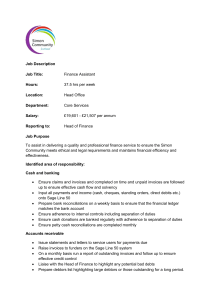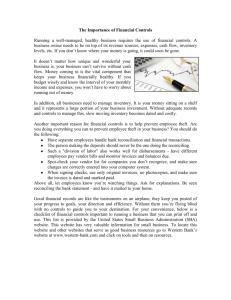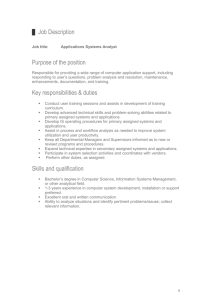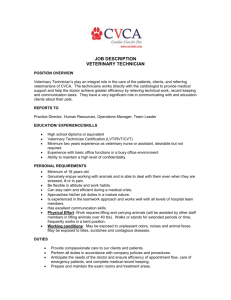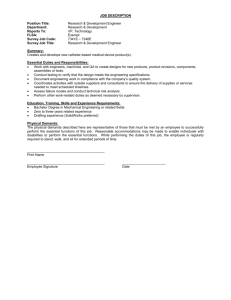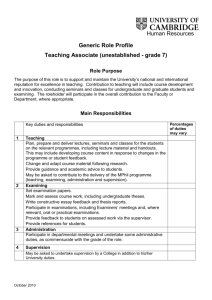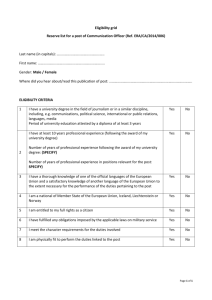Internal Controls Checklist
advertisement
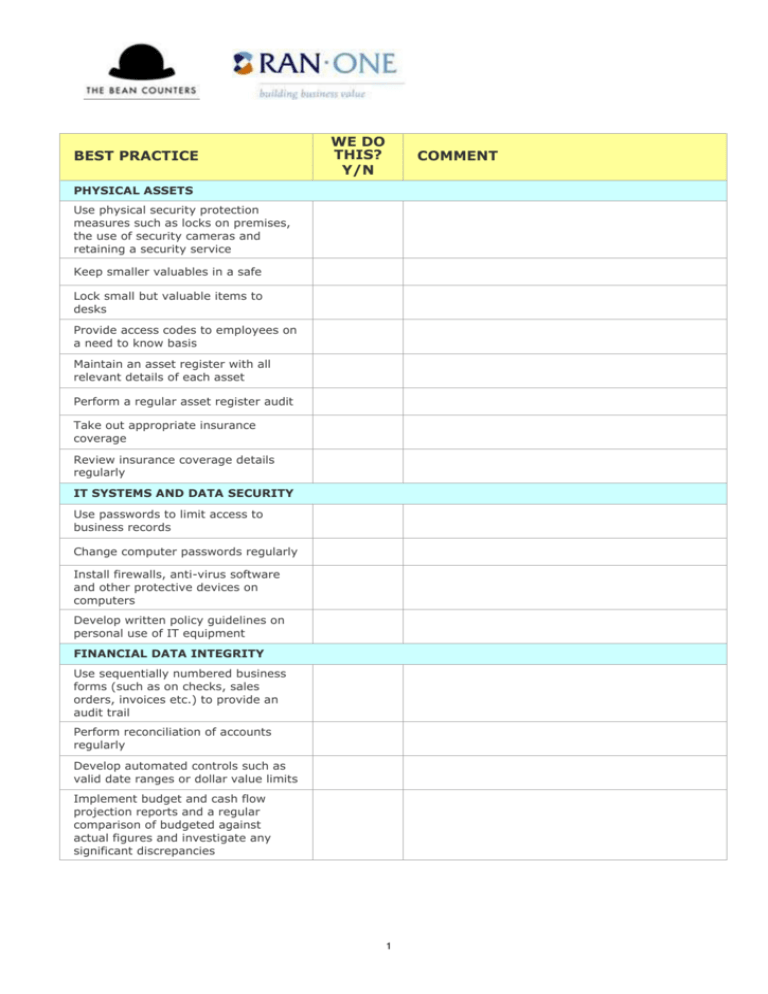
BEST PRACTICE WE DO THIS? Y/N COMMENT PHYSICAL ASSETS Use physical security protection measures such as locks on premises, the use of security cameras and retaining a security service Keep smaller valuables in a safe Lock small but valuable items to desks Provide access codes to employees on a need to know basis Maintain an asset register with all relevant details of each asset Perform a regular asset register audit Take out appropriate insurance coverage Review insurance coverage details regularly IT SYSTEMS AND DATA SECURITY Use passwords to limit access to business records Change computer passwords regularly Install firewalls, anti-virus software and other protective devices on computers Develop written policy guidelines on personal use of IT equipment FINANCIAL DATA INTEGRITY Use sequentially numbered business forms (such as on checks, sales orders, invoices etc.) to provide an audit trail Perform reconciliation of accounts regularly Develop automated controls such as valid date ranges or dollar value limits Implement budget and cash flow projection reports and a regular comparison of budgeted against actual figures and investigate any significant discrepancies 1 Segregate the duties involved in financial transactions such as ordering, recording and paying for purchases Assign particular responsibilities to particular people Institute supervisor level checking of financial records Build in validation checks to processes, for instance checking invoice totals against the individual items on the invoice to ensure correctness Carry out exception routines such as spot checks or reviews Develop a hierarchy of spending level approval authority Rotate duties involved in financial transactions and recording such as petty cash and receipting Keep sufficient financial record details to provide useful management information e.g. double entry bookkeeping Maintain books and records up-todate and balanced Ensure employees with financial functions take their annual vacations Develop a records retention schedule ACCOUNTS RECEIVABLE Develop and document a credit approval/balance limit policy; include information on who must authorize new applications Conduct credit checks on new credit customers Develop an aged accounts procedure that includes regular reporting and follow up on aging accounts Record credit purchases as soon as the transaction occurs Keep the duties involved in accounts receivable separate from cash receipting Have transactions such as non-cash credits and write off of bad debts cross checked Review credit balances on a regular basis 2 Use numerical or batch processing controls over billing Cross check early payment discounts and penalties on overdue accounts Ensure mailing of accounts cannot be tapered with and Separate mailing duties from statement preparation duties Prepare trial balance of individual accounts receivable regularly Reconcile trial balances with general ledger control accounts ACCOUNTS PAYABLE Develop and document a purchasing and accounts payable procedure including authorization levels and any price comparison requirements prior to purchase Pay on original invoices only to avoid duplicate payment Mark paid invoices to prevent resubmission or double payment Set payment amount authorization permissions Separate the duties of handling refund checks from suppliers from invoicing duties Check invoices from suspect sources e.g. businesses with only a post office box address Separate the duties of approving new suppliers from responsibility for payment of their invoices Check the record of supplier billing each month and investigate any suspicious activity e.g. rapidly increasing purchases from one vendor Carry out random checks of the invoices of individual suppliers Investigate invoices for poorly defined services e.g. listing the business in a directory Develop a process that brings together the purchasing order and receiving reports, along with the check for payment, for review before signature Develop a procedure that ensures direct shipments to customers are properly billed to them 3 SALES Develop and document a pricing and discounting policy including authorisation to vary rules Check sales figures against their individual source such as invoices If salespeople work on commission ensure that their sales figures are valid Don’t pay commissions to salespeople until monies are received Reconcile sales register records with cash takings and credit card receipts Dispatch goods COD or with a copy of the invoice Require evidence of delivery Record orders on pre-numbered forms Compare sales invoices to shipping documents before dispatching Record sales invoices promptly Have customer complaints handled independently of the sales department HANDLING CASH AND CHECKS Keep check books in secure storage Use pre-numbered checks Endorse checks ‘for deposit only’ Enter check details in a way to prevent easy alteration Maintain a check register and review checks against it regularly but at varying (unpredictable) intervals Mutilate voided checks before disposing of them Use a cash register to keep a record of cash sales Balance cash tills daily or more regularly according to the amount of cash handled Balance cash at the end of each shift where another employee is taking over transactions Post cash receipts to appropriate journals promptly 4 Deposit cash receipts regularly to minimize the amount on hand Reconcile bank accounts monthly and give check related duties to separate employees e.g. reconciliation, check authorization, mail opening, writing deposit slips, banking Separate duties for cash disbursement and purchases from the approval process Conduct audits on a varying (unpredictable) schedule and do not warn employees of the date Impose a limit on the amount of petty cash held and the money value limit of petty cash purchases Require that petty cash reimbursement requests be for preapproved purchases only and supported by approved types of documentation Keep petty cash in a secure repository Require a second signatory for petty cash disbursement Periodically have petty cash audited by a person separate from the person who pays out from petty cash RECEIPT OF GOODS Inspect goods for condition at time of receipt Check goods against order before approving payment Use pre-numbered receiving dockets Pass invoices to accounts for payment promptly Develop and document a procedure for dealing with partial receipt and claims for damaged goods PAYROLL Maintain security over payroll system passwords and change them regularly Review bank account deposits to ensure that each pay goes to a different bank account Separate payroll preparation, disbursement and distribution duties Check payroll budgeted figure against payroll actual figure and investigate variations 5 Maintain accurate employee attendance records Reconcile salesperson’s commission records with their records of sales Maintain complete and accurate payroll records for holiday and sick leave entitlements and leave used Use direct bank deposits for pays Ensure that more than one person can process the payroll Separate the duties of personnel records management and payroll Develop and document a policy on allowable payroll deductions and who can authorize them Maintain security over attendance recording systems Periodically review the payroll register against actual employees COMPETENT AND ETHICAL EMPLOYEES Develop a competency based hiring policy Run reference checks on job applicants to ensure they do have the essential qualifications and skill level required by the position Ensure new employees are adequately trained in routines and procedures Provide adequate employee supervision Implement a performance management system Provide clear job description and role responsibility documentation for employees Develop lines of communication with employees such as suggestion boxes, team meetings etc. Bond employees who deal with sensitive information Provide employees with a copy of the internal control system policy explaining its value to the business and the consequences of noncompliance Institute a confidentiality guaranteed employee feedback mechanism 6 COMPLIANCE WITH EXTERNALLY IMPOSED LAWS AND REGULATIONS Develop policies on, and where possible assign responsibility for compliance with, particular legislative requirements e.g. by using fire wardens, an occupational safety and health officer etc. Implement physical controls to prevent accidents Develop registers to record government mandated information requirements e.g. chemical spills Create a schedule for preparing and submitting mandated information or reports 7

